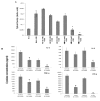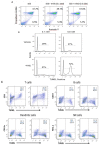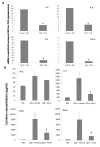Treatment with the hyaluronic acid synthesis inhibitor 4-methylumbelliferone suppresses SEB-induced lung inflammation
- PMID: 24141285
- PMCID: PMC3813913
- DOI: 10.3390/toxins5101814
Treatment with the hyaluronic acid synthesis inhibitor 4-methylumbelliferone suppresses SEB-induced lung inflammation
Abstract
Exposure to bacterial superantigens, such as staphylococcal enterotoxin B (SEB), can lead to the induction of acute lung injury/acute respiratory distress syndrome (ALI/ARDS). To date, there are no known effective treatments for SEB-induced inflammation. In the current study we investigated the potential use of the hyaluronic acid synthase inhibitor 4-methylumbelliferone (4-MU) on staphylococcal enterotoxin B (SEB) induced acute lung inflammation. Culturing SEB-activated immune cells with 4-MU led to reduced proliferation, reduced cytokine production as well as an increase in apoptosis when compared to untreated cells. Treatment of mice with 4-MU led to protection from SEB-induced lung injury. Specifically, 4-MU treatment led to a reduction in SEB-induced HA levels, reduction in lung permeability, and reduced pro-inflammatory cytokine production. Taken together, these results suggest that use of 4-MU to target hyaluronic acid production may be an effective treatment for the inflammatory response following exposure to SEB.
Figures





Similar articles
-
Treatment with the hyaluronic Acid synthesis inhibitor 4-methylumbelliferone suppresses LPS-induced lung inflammation.Inflammation. 2015;38(3):1250-9. doi: 10.1007/s10753-014-0092-y. Inflammation. 2015. PMID: 25537799
-
The role of hyaluronic acid in SEB-induced acute lung inflammation.Clin Immunol. 2013 Jan;146(1):56-69. doi: 10.1016/j.clim.2012.11.002. Epub 2012 Nov 14. Clin Immunol. 2013. PMID: 23246605
-
CD44 as a novel target for treatment of staphylococcal enterotoxin B-induced acute inflammatory lung injury.Clin Immunol. 2012 Jul;144(1):41-52. doi: 10.1016/j.clim.2012.05.001. Epub 2012 May 11. Clin Immunol. 2012. PMID: 22659034
-
Multiple anti-inflammatory pathways triggered by resveratrol lead to amelioration of staphylococcal enterotoxin B-induced lung injury.Br J Pharmacol. 2012 Nov;167(6):1244-58. doi: 10.1111/j.1476-5381.2012.02063.x. Br J Pharmacol. 2012. PMID: 22646800 Free PMC article.
-
Resveratrol-mediated attenuation of superantigen-driven acute respiratory distress syndrome is mediated by microbiota in the lungs and gut.Pharmacol Res. 2021 May;167:105548. doi: 10.1016/j.phrs.2021.105548. Epub 2021 Mar 15. Pharmacol Res. 2021. PMID: 33722710 Free PMC article.
Cited by
-
4-Methylumbelliferone suppresses hyaluronan and adipogenesis in primary cultured orbital fibroblasts from Graves' orbitopathy.Graefes Arch Clin Exp Ophthalmol. 2020 May;258(5):1095-1102. doi: 10.1007/s00417-019-04528-3. Epub 2020 Jan 3. Graefes Arch Clin Exp Ophthalmol. 2020. PMID: 31900640
-
A mechanistic model and therapeutic interventions for COVID-19 involving a RAS-mediated bradykinin storm.Elife. 2020 Jul 7;9:e59177. doi: 10.7554/eLife.59177. Elife. 2020. PMID: 32633718 Free PMC article.
-
Interfering with hyaluronic acid metabolism suppresses glioma cell proliferation by regulating autophagy.Cell Death Dis. 2021 May 13;12(5):486. doi: 10.1038/s41419-021-03747-z. Cell Death Dis. 2021. PMID: 33986244 Free PMC article.
-
Oral hymecromone decreases hyaluronan in human study participants.J Clin Invest. 2022 May 2;132(9):e157983. doi: 10.1172/JCI157983. J Clin Invest. 2022. PMID: 35499083 Free PMC article. Clinical Trial.
-
Enterotoxins: Microbial Proteins and Host Cell Dysregulation.Toxins (Basel). 2016 Jan;8(1):17. doi: 10.3390/toxins8010017. Toxins (Basel). 2016. PMID: 27096148 Free PMC article. No abstract available.
References
-
- Marrack P., Kappler J. The staphylococcal enterotoxins and their relatives. Science. 1990;248:705–711. - PubMed
-
- Rajagopalan G., Sen M.M., Singh M., Murali N.S., Nath K.A., Iijima K., Kita H., Leontovich A.A., Gopinathan U., Patel R., et al. Intranasal exposure to staphylococcal enterotoxin B elicits an acute systemic inflammatory response. Shock. 2006;25:647–656. doi: 10.1097/01.shk.0000209565.92445.7d. - DOI - PubMed
Publication types
MeSH terms
Substances
LinkOut - more resources
Full Text Sources
Other Literature Sources
Medical
Research Materials

